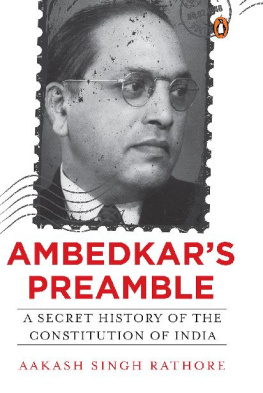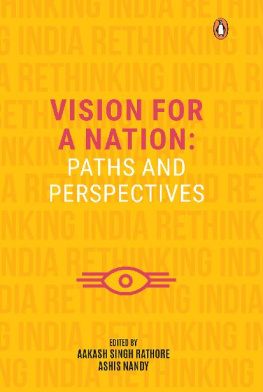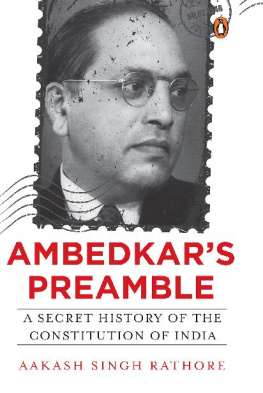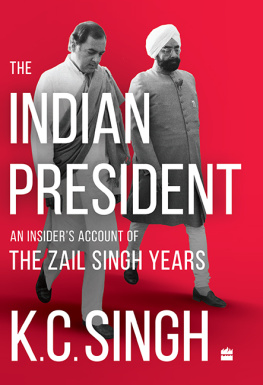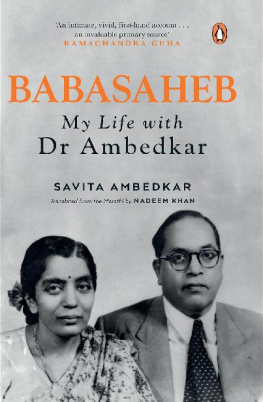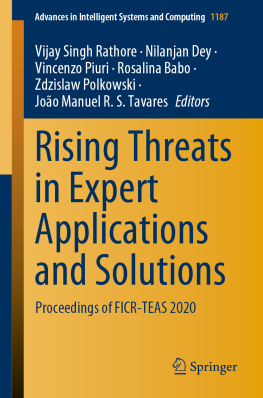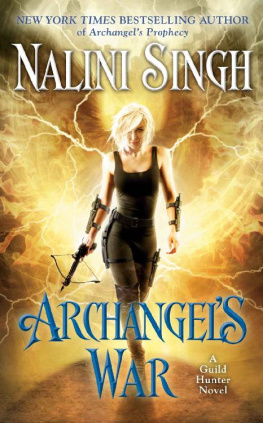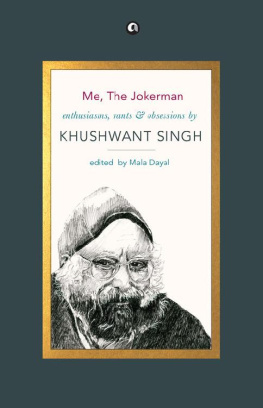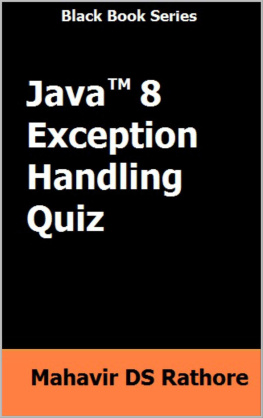Aakash Singh Rathore - Becoming Babasaheb
Here you can read online Aakash Singh Rathore - Becoming Babasaheb full text of the book (entire story) in english for free. Download pdf and epub, get meaning, cover and reviews about this ebook. year: 2023, publisher: HarperCollins Publishers India, genre: Detective and thriller. Description of the work, (preface) as well as reviews are available. Best literature library LitArk.com created for fans of good reading and offers a wide selection of genres:
Romance novel
Science fiction
Adventure
Detective
Science
History
Home and family
Prose
Art
Politics
Computer
Non-fiction
Religion
Business
Children
Humor
Choose a favorite category and find really read worthwhile books. Enjoy immersion in the world of imagination, feel the emotions of the characters or learn something new for yourself, make an fascinating discovery.

- Book:Becoming Babasaheb
- Author:
- Publisher:HarperCollins Publishers India
- Genre:
- Year:2023
- Rating:5 / 5
- Favourites:Add to favourites
- Your mark:
- 100
- 1
- 2
- 3
- 4
- 5
Becoming Babasaheb: summary, description and annotation
We offer to read an annotation, description, summary or preface (depends on what the author of the book "Becoming Babasaheb" wrote himself). If you haven't found the necessary information about the book — write in the comments, we will try to find it.
Becoming Babasaheb — read online for free the complete book (whole text) full work
Below is the text of the book, divided by pages. System saving the place of the last page read, allows you to conveniently read the book "Becoming Babasaheb" online for free, without having to search again every time where you left off. Put a bookmark, and you can go to the page where you finished reading at any time.
Font size:
Interval:
Bookmark:

For the Khobragades
Contents
P rimrose Hill in northernish London is pretty bougie now, but with the railway line that has run through it for nearly two centuriesits tracks crossing the back garden of 10 King Henrys Road, aka the Ambedkar House Museum, Londonin the early 1920s, when young Ambedkar lived there, the neighbourhood would have been chronically caked in soot from the black smoke and dirt pouring out of every passing steam locomotive. Ambedkars small, square-shaped single room was at the back of the house, grimly overlooking the railway tracks through a solitary window. The walk from that small bedroom down to the massive and ornate reading room of the British Museum and Library would have taken him around fifty minutes on a fair day. I have myself plodded it several times.
What is now the French consulate, at 21 Cromwell Road, just south of Londons Hyde Park, used to lodge the National Indian Association as well as the Northbrook Indian Society. It also lodged a very young Ambedkar in 1916. It is about an hours walk from there to Grays Inn, where Ambedkar sat in on law classes for passing the bar exam, and only forty-five minutes to the London School of Economics Passmore Edwards Hall on Clare Market, where he had enrolled for his second masters degree in economics. Ive ambled through these routes too.
Whether its the Kings Crown Hotel on West 116th Street in New York, an old brownstone at 554 West 114th Street in New York, or 95 Brook Green in Hammersmith, London; whether its rooms 50 and 51 of the Number 1 BIT Chawl in Parel, Damodar Hall in Parel, or Rajgruha in Dadar, Mumbai; whether its 26 Alipur Road in Delhi; Gaekwad Wada (now known as Kesari Wada) in Narayan Peth, Pune; or the site of the old Dak Bungalow in MahadI have spent time at every known address where Ambedkar may have experienced a moment of personal significance, trying to recreate it in my mind, imagining how it all must have played out, trying to feel it somehow.
This technique has served me well in a decade-long effort at capturing something of his clearly manifest yet elusive personality. This personalitycomplex, charismatic, kind, conflictedhas never really seemed to me to come through at all in any biography of Ambedkar that I have read. Many of them are lifeless lives. After all the time that I have spent attempting to walk in Ambedkars footsteps, I am hopeful that his pulse will reverberate in this one.
When I speak to anyone who knows anything about the life of Dr Ambedkar, the first thing that they want to know from me is how my biography will be different from those that have come earlierand there have been quite a few. I have given a variety of replies, but my answer really boils down to two main things. The first is what I have just mentioned, that I have sought to foreground Ambedkar as an individual, rather than produce a bloodless political or intellectual biography; and the second is that I have sought to be more consistent with historical accuracy than the other biographies now available.
The former point being less audacious, Ill expand a bit more upon it first.
What really intrigues me about Dr Ambedkar, perhaps even more than his historic accomplishments, is his personalitymore accurately, how elusive it has been for biographers. Because he meant so many different things to so many different people, it is genuinely difficult to try to make objective sense of what he was really like. This difficulty is compounded by the fact that Ambedkar was actually a complex, multidimensional person.
In this book, who he was as he was doing all of it.
This is the opposite of Shashi Tharoors approach in his recent biography, Ambedkar: A Life. He states at the outset,
The biography of a man who is principally noted for his words rather than his actions inevitably suffers from a deficiency of incidents and a surfeit of ideas. There is undoubtedly drama and suffering in Ambedkars life, but far more consequential
We dont want to follow that formula. It is the same as has been done so often in the past by all of the anglophone biographers (Eleanor Zelliot, Christophe Jaffrelot, Gail Omvedt and so on). So no more lifeless lives of Dr Ambedkar. In the pages that follow, there will be blood.
Quite in contrast to the bloodless narrative of anglophone biographers, Dr Ambedkars widow, Savita Ambedkar, in her own autobiography had focused almost exclusively on Ambedkar as a man, a husband and a person. Her book, we might say by reversing Shashi Tharoors expression, suffers from a surfeit of incidents and a deficiency of ideas. But importantly, she made a point that should here be noted:
Dr Ambedkar possessed an impressive personality. His grand forehead, his bright, piercing eyes, his sharp look, his ultra-modern, tip-top attire, the lustre that rested upon his visagethe very first sight of him gave assurance of an utterly exceptional personality.
In such a which, to anyone who actually knows something about the life and times of Ambedkar, reeks so much of bullshit that it waters the eyes.
Speaking of bullshit transitions us rather nicely to the more contentious point I make about historical accuracy. It is an obvious generalizationbut I still
I do not know how to sugar-coat this, so I am just going to come out and say it: Both of these hugely influential, classic, standard and even authoritative biographies of Ambedkar are
The audacity of this claim may seem even more egregious when we note that the book cover of Keers biography carries a starburst reading, The one and only authentic biography read and approved by Dr Ambedkar himself! Or otherwise, when we note that Khairmodaythe person who first referred to Ambedkar as Babasahebhimself worked as an archivist for Ambedkar, gathering innumerable documents to form one of the largest collections of Ambedkar-related source materials available, originally housed at Ambedkars own Siddharth College. And yet, despite the odds, I have to assert that the claim is sadly true.
We to describe. For example, he mentions the wrong years for his own period of study in New York and London. He also misdates his sojourn in Baroda (now Vadodara). It is hardly surprising, then, that if Ambedkars biographers relied only upon his own recollections during interviews, that errors did very often creep in.
Keer did not seem to try to authenticate his information with any other sources at all. Khairmoday, however, was more punctilious. The problems arose for Khairmoday when the other sources that he was relying upon themselves misinformed him. This happened, for example, when seeking information from the London School of Economics about Ambedkars period of study in England. Khairmoday was fed inaccurate information by the registrar of the University of London, as well as by the secretary of LSE. A brief reply by the latter, J. Mair, to a letter of inquiry asking about Ambedkar is a perfect example of the kind and quantity of misinformation that London universities have consistently been disseminating about him over the past 100 years:
3rd May, 1922
Dear Sir,
With reference to your letter , Mr. B.R. Ambedkar was a student from October, 1919, to June, 1921 He was successful in obtaining the Degree of M.Sc. (Econ.) in July last, and I believe, then returned to India.
Yours faithfully,
[signed]
Secretary.
This entire letter in its original comprises only two sentences and yet contains three errors: Ambedkar joined LSE in 1920, not 1919; Mrs Mair, who only became school secretary in 1920, had herself enrolled him. Ambedkar obtained the MSc in June 1921, not in July; and he did not return to India after receiving the MSc but stayed on in pursuit of the doctorate. Unbelievably, this letter was issued while Ambedkar was still right there in London!
Next pageFont size:
Interval:
Bookmark:
Similar books «Becoming Babasaheb»
Look at similar books to Becoming Babasaheb. We have selected literature similar in name and meaning in the hope of providing readers with more options to find new, interesting, not yet read works.
Discussion, reviews of the book Becoming Babasaheb and just readers' own opinions. Leave your comments, write what you think about the work, its meaning or the main characters. Specify what exactly you liked and what you didn't like, and why you think so.

